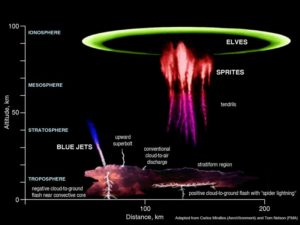
Electricity in the Universe has been identified from beneath our feet, in animals and plants, our biosphere, and out to the furthest reaches of the Universe. In general, electricity is present wherever we find plasma, and since 99.999% of the visible universe is in the plasma state, magnetic field and electric currents are nearly everywhere.
This page summarises where electricity and electric currents have been considered to be important. Each item is supported by peer reviewed papers from scientists in a number of different disciplines.
Terrestrial electricity
Telluric currents (Subterranean electricity)
- See also: Telluric current on Wikipedia
- Underground currents up to a million amps have been discovered in Australia.[1]
- Telluric currents have been discovered in Arizon in the San Francisco Peaks volcanic field.[2]
- Earth’s core: “Electric currents of about a billion amps flow across the boundary between the solid inner core and the fluid outer core that lies around it.”[3]
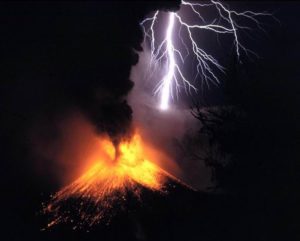
Atmospheric electricity
- See also: Atmospheric electricity
“Meteors are atmospheric phenomena observed in the atmosphere or at the surface of the earth”.[4] “Electrometeors” are “visible or audible manifestation of atmospheric electricity”,[5] ie. “.. phenomena resulting from the interaction of electric charges with the atmosphere. Examples of such phenomena are storms, lightning, thunder, St Elmo’s fires and polar aurora”.[4]
- Lightning is probably the most common and well-accepted form of terrestrial electricity
- Fair weather field is the measured voltage different between the ground and upper atmosphere
- St Elmos Fire is a well-documented, but less common form of electrical discharge
- Auroras are an electrical phenomena in the upper atmosphere.[6]
- Red sprites [7]
- Blue jets
- Gigantic jets (upward lightning) that can travel more than 60km (40 miles) into the ionosphere.[8]
- Elves: the acronym stands for “Emissions of Light and Very low frequency perturbations from Electromagnetically pulsed Sources”)
- Tigers: (Transient Ionospheric Glow Emission in Red)[9]
- Trolls: (Transient Red Optical Luminous Lineament)
- Gnomes and *Pixies [10]
- Clouds on earth blown by the solar wind.[11]
Ionopshere
- Birkeland currents are electric currents that power the aurora (on Earth and other planets),[12] and carry about a million amps.[13]
- Ionospheric electric currents have been recognised for several centuries.[14]
- Giant electric currents in the sky[14b]
Biological electricity
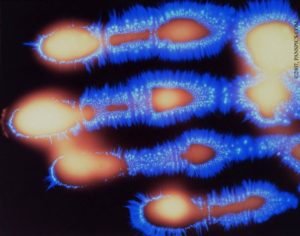
- Electric fields may shape tissue.[15]
- Electric fish: there are over 300 species of fish and eels that can generate electric fields. (See Electric fish on Wikipedia)
- The Duck-billed platypus bill detects weak electric fields generated from the minute electrical signals passing between nerves and muscles in the tail of prey such as shrimp.[16]
- Neurons fire electrochemical signals.[17]
- Rattlesnakes generate 75-100 volts when shaken! The electrostatics may be used to sense their environment.[18]
Extraterrestrial (cosmic) electricity
General cosmic electricity
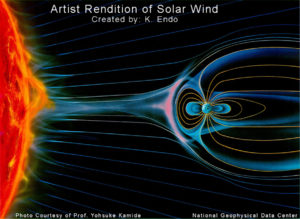
- Cosmic electricity: “Almost all cosmic plasmas that have been studied in detail seem to be penetrated by magnetic fields. The presence of the magnetic fields implies that considerable electric currents must exist in the cosmic plasmas. As has been stressed by Alfvén such currents often have a pronounced tendency to flow in relatively thin filamentary and sheet structures. Nearby examples of this are found in the ionosphere and magnetosphere of the Earth. In situ measurements show that currents here flow in a complex network of filaments and sheets. Also in more distant plasmas like the chromosphere and corona of the sun, the solar wind, and the interstellar medium we find thin structures in the form of filaments and sheets. There is strong evidence that many of these narrow structures are subject to the pinching action of electric currents.”[19][20]
Near-Earth electricity
- Neutral sheet and near-earth magnetotail flux ropes whose “field-aligned current within these ropes may approach a million amps”.[21]
Solar electricity
- Solar flares produce current loops.[22] [23] [24] [25]
- Solar Corona produces current sheets.[26]
- Sun spots [27]
Interplanetary electricity
- Heliospheric current sheet carries about 3×109 amperes, [28] with a current density of around 10-10 amps/m2 (space is big!)
- Interplanetary electric field has the same extent as the heliospheric current sheet, but the current run north-south.[29] [30]
- Flux ropes (Birkeland currents) between the Sun and Earth were discovered by the THEMIS spacecraft, carrying 650,000 Amps to the Artic aurora.[31] [32]
- Solar wind [33]
Galactic electricity
- Astrophysical jets carry electric currents [34] [35] that have been estimated at up to 1018 Amps.[36]
Intergalactic electricity
- Galactic current sheet: the analog of the “Heliospheric current sheet” is estimated to carry 1017 – 1019 Amps.[37]
- Extragalactic jets (the analog of galactic astrophysical jets) carry electric currents.[38]
Comets
- Comet nuclei charge electrostatically.[39]
- Comet dust charges electrostatically causing it to levitate from the comet surface.[40]
- Cometary current system: plasma tail streamers separated by a neutral current sheet, has a total current exceeding 108A.[41]
- Cometary plasma tails, generate magnetic fields and electric currents of up to a billion Amp.[42]
- Cometary atmosphere feature electric currents.[43]
- Cometary aurora due to “current discharges into the atmosphere from the tail.[44]
Venus’ tail (flux ropes)
- Venus current system: Pioneer Venus Orbiter identified an induced electric field in the tail, and magnetic field reversals indicative of electric currents.[45] [46]
Meteoroids
- Meteoroids: “… in space are electrically charged due to cosmic rays, solar UV, and other effects (solar wind and ions and electron impacts)”[47]
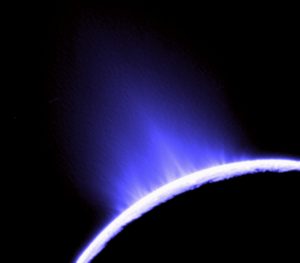
Lunar charging[47a]
- Moon dust: charges due to photoelectric effect,[48][49] interaction with the local plasma environment, [50] and contact charging.[51] that results in levitation of the lunar dust,[52] (sometimes called Moon Fountains)[53], up to altitudes of up to 100km.[54] Lunar craters charge too.[55]
- Surface of the Moon: “the moon’s surface becomes electrified during each full moon. The moon passes through the Earth’s magnetotail, a cone of highly-charged particles, for about 6 days each month. On the side of the moon facing the sun, ultraviolet particles disrupt the electromagnetic effect, keeping the voltage at low levels, but on the dark side, the voltage can reach hundreds or thousands of volts.”[56][57]
Io-Jupiter flux tube
- Io-Jupiter flux tube: as Io crosses through Jupiter’s atmosphere, an electric current is generated estimated at 10 million amps.[58][59]
Io’s volcanoes
- Io’s volcanoes have been suggested to be powered electrically.[60]
Enceladus’ Plumes
Saturn’s moon Enceladus has electrically charged ice particles making up its plumes.[61]
Refererences
- ↑ “Huge Underground Electrical Circuit“, Science Frontiers, No. 54: Nov-Dec 1987. Citing: “Scientists Discover Huge Underground Circuit,” Monash Review, p. 10, December 1986, Cr. R.E. Molnar
- ↑ “Subterranean Electric Currents“, Science Frontiers, No. 36: Nov-Dec 1984. Citing: Towle, James N.; “The Anomalous Geomagnetic Variation Field and Geoelectric Structure Associated with the Mesa Butte Fault System, Arizona,” Geological Society of America, Bulletin, 95:221, February 1984
- ↑ “The motor of the world“, Science Frontiers, No. 108: Nov-Dec 1996. Citing: Stokstad, Erik; “Earth’s Heart Is in a Spin,” New Scientist, p. 18, July 20, 1996. The basic paper is: Song, Xiadong, and Richards, Paul G.; “Seismological Evidence for Differential Rotation of the Earth”s Inner Core“, Nature, 382:221, 1996
- ↑ ab Hervé Sizun (Translated by P.de Fornel), “2.4.13 Meteors“, Radio Wave Propagation for Telecommunication Applications, Publ. Springer Science & Business Media, 2006 (page 30)
- ↑ “Electrometeors“, International Cloud Atlas, World Meteorological Organization. Retrieved 23 March 2017
- ↑ Stern, D. P., “Electric currents and voltage drops along auroral field lines“, Space Science Reviews, vol. 34, Mar. 1983, p. 317-325
- ↑ Andrew Alden, “Sprites and Their Siblings“, About.com
- ↑ “Upwards lightning caught on film“, BBC News web site, Sunday, 23 August 2009
- ↑ “Andrew Alden, A Glimpse of a TIGER” About.com
- ↑ Walter A. Lyons, CCM, Thomas E. Nelson, Russell A. Armstrong, Victor P. Pasko, and Mark A. Stanley, “Upward Electrical Discharges From Thunderstorm Tops”, Bulletin of the American Meteorological Society, Volume 84, Issue 4 (April 2003) (PDF)
- ↑ M Voiculescu, et al, “Clouds blown by the solar wind”, Environmental Research Letters, Volume 8 Number 4, October-December 2013 (abstract and full text)
- ↑ “Birkeland current” on Wikipedia
- ↑ G. A. Germany, P. G. Richards G. K. Parks, M. Brittnacher, and J. F. Spann, “Global auroral imaging as a remote diagnostic of geospace” presented at AIAA Plasmadynamics and Lasers Conference, June 25, 1997
- ↑ Christine Amory-Mazaudier., “On the electric current systems in the Earth’s environment some historical aspect: Part I: external part / ionosphere / quiet variation; | Part II : external part/ ionosphere/ disturbed variation, Published in a book of History of geomagnetism and aeronomy, Solar variability and Geomagnetism, lectures from the IAGA Assembly in Hanoï 2001, collected and edited by W. Schröder, pp 154-190, Science edition AKGGKP, Bremen-Rönnebeck, Postdam, 2002
- (b)↑ NASA Rocket, Satellite Tag-Team to View the Giant Electric Current in the Sky, Jul 2, 2021 @ NASA.GOV, and, Strong Winds Power Electric Fields in the Upper Atmosphere, NASA’s ICON Finds, Nov 29, 2021
- ↑ “The Currents Of Life“, Science Frontiers, No. 12: Fall 1980. Citing: “Electric Charges May Shape Living Tissue,” New Scientist, 86:245, 1980
- ↑ “Platypus Bill An Electrical Probe“, Science Frontiers, No. 45: May-Jun 1986. Cited in “The Battery-Operated Duck-Billed Platypus,” New Scientist, p. 25, February 13, 1986
- ↑Neuron at Wikipedia
- ↑Electric Snakes, Science Frontiers, No. 96: Nov-Dec 1994. Citing: Vonstille, W.T., and Stille, W.T., III; “Electrostatic Sense in Rattlesnakes“, Nature, 370:184, 1994
- ↑ Carlqvist, Per, “Cosmic electric currents and the generalized Bennett relation“, Astrophysics and Space Science (ISSN 0004-640X), vol. 144, no. 1-2, May 1988, p. 73-84
- ↑ Alfvén, H. (1977), “Electric currents in cosmic plasmas, Rev. Geophys., 15(3), 271-284.
- ↑ Elphic, R. C.; Russell, C. T.; Cattell, C. A.; Takahasi, K.; Bame, S. J., “ISEE-1 and 2 observations of magnetic flux ropes in the magnetotail – FTE’s in the plasma sheet?” Geophysical Research Letters (ISSN 0094-8276), vol. 13, July 1986, p. 648-651.
- ↑ Hannes Alfvén, per Carlqvist “Currents in the Solar Atmosphere and a Theory of Solar Flares” (1967) Solar Physics, Vol. 1, p.220
- ↑ Carlqvist, P., “Current Limitation and Solar Flares” (1969) Solar Physics, Vol. 7, p.377
- ↑ Karlicky, M., “Evolution of force-free electric currents in the solar atmosphere” (1997) Astronomy and Astrophysics, v.318, p.289-292
- ↑ Zaitsev, V. V.; Stepanov, A. V., “Towards the circuit theory of solar flares” (1992) Solar Physics (ISSN 0038-0938), vol. 139, no. 2, June 1992, p. 343-356
- ↑ Strauss, H. R.; Otani, N. F., “Current sheets in the solar corona” (1988) Astrophysical Journal, Part 1 (ISSN 0004-637X), vol. 326, March 1, 1988, p. 418-424
- ↑ Jayanthan, R., “Electric Current in a Sunspot“, Solar Physics, Volume 12, Issue 1, pp.104-105. April 1970.
- ↑ Israelevich, P. L., et al, “MHD simulation of the three-dimensional structure of the heliospheric current sheet” (2001) Astronomy and Astrophysics, v.376, p.288-291
- ↑ Duncan Alan Bryant, Electron Acceleration in the Aurora and Beyond, Published 1999, CRC Press, 311 pages, ISBN 0750305339 (page 176)
- ↑ Gerd W. Prölss, Physics of the Earth’s Space Environment: An Introduction, (2004) Translated by M. K. Bird, Springer, 514 pages, ISBN 3540214267 (pages 312-313)
- ↑ “NASA Spacecraft Make New Discoveries About Northern Lights“
- ↑ “Multimedia for the Press Event for THEMIS” See Image 10: “Flux Ropes Power the Magnetosphere!: THEMIS discovered a flux rope pumping a 650,000 Amp current into the Arctic. “
- ↑ Coleman, P., Jr. (1975), “Electric Currents in the Solar Wind“, J. Geophys. Res., 80(34), 4719-4724.
- ↑ Appl, S.; Camenzind, M. “The stability of current-carrying jets” (1992) Astronomy and Astrophysics (ISSN 0004-6361), vol. 256, no. 2, p. 354-370
- ↑ Baty, H. “On the magnetohydrodynamic stability of current-carrying jets” (2005) Astronomy and Astrophysics, v.430, p.9-17
- ↑ Philipp P. Kronberg et al, “Measurement of the Electric Current in a Kpc-Scale Jet“, arXiv:1106.1397, (7 Jun 2011)
- ↑ Hannes Alfvén and Per Carlqvist, “Interstellar clouds and the formation of stars]” (1978) in Astrophysics and Space Science, vol. 55, no. 2, May 1978, p. 487-509
- ↑ Jafelice, Luiz C.; Opher, Reuven; Assis, Altair S.; Busnardo-Neto, Jose, “Current generation in extragalactic jets by Cherenkov damping of magnetohydrodynamic waves” (1990) Astrophysical Journal, Part 1 (ISSN 0004-637X), vol. 348, Jan. 1, 1990, p. 61-72
- ↑ Mendis, D. A.; Hill, J. R.; Houpis, H. L. F.; Whipple, E. C, “On the electrostatic charging of the cometary nucleus” (1981) Astrophysical Journal, Part 1, vol. 249, Oct. 15, 1981, p. 787-797.
- ↑ Mendis, D. A.; Rosenberg, M., “Cosmic Dusty Plasmas” (1994) Annual Review of Astronomy and Astrophysics, Volume 32, 1994, pp. 419-463
- ↑ Mendis, D. A., “On the hydromagnetic model of comets]” (1978) Moon and the Planets, vol. 18, May 1978, p. 361-369
- ↑ Ip, W.-H.; Mendis, D. A., “The generation of magnetic fields and electric currents in cometary plasma tails” (1976) Icarus, vol. 29, Sept. 1976, p. 147-151
- ↑ Ip, W.-H., “Currents in the cometary atmosphere” (1979) Planetary and Space Science, vol. 27, Feb. 1979, p. 121-125
- ↑ Houpis, H. L. F.; Mendis, D. A., “On the development and global oscillations of cometary ionospheres” (1981) Astrophysical Journal, Part 1, vol. 243, Feb. 1, 1981, p. 1088-1102.
- ↑ Intriligator, D. S.; Scarf, F. L., “Wave-particle interactions in the Venus wake and tail” (1984), Journal of Geophysical Research (ISSN 0148-0227), vol. 89, Jan. 1, 1984, p. 47-55
- ↑ Alfven, H., Cosmic plasma (1981) Astrophysics and Space Science Library. Volume 82), 1981. “III.5.3. “Current Systems in the Magnetosphere of Venus” Page 62
- ↑ Edmond Murad, Iwan P. Williams, “Meteors in the Earth’s Atmosphere: Meteoroids and Cosmic Dust and their Interactions with the Earth’s Upper Atmosphere” (2002) Cambridge University Press, ISBN 0521804310 (p.257)
- a↑ Andrews, Robin George “The Moon Is Electric—Especially When It’s Full“, National Geographic magazine, September 18, 2018
- ↑ de, Bibhas R.; Criswell, David R., “Intense localized photoelectric charging in the lunar sunset terminator region 1. Development of potentials and fields” Journal of Geophysical Research, Volume 82, Issue A7, March 1, 1977, pp.999-1004
- ↑ Pelizzari, M. A.; Criswell, D. R., “Lunar dust transport by photoelectric charging at sunset“, In: Lunar and Planetary Science Conference, 9th, Houston, Tex., March 13-17, 1978, Proceedings. Volume 3. (A79-39253 16-91) New York, Pergamon Press, Inc., 1978, p. 3225-3237.
- ↑ Timothy J. Stubbs, “A dynamic fountain model for lunar dust“, Advances in Space Research, Volume 37, Issue 1, 2006, Pages 59-66
- ↑ Sternovsky, Z., S. Robertson, A. Sickafoose, J. Colwell, and M. Horányi (2002), “Contact charging of lunar and Martian dust simulants, J. Geophys. Res., 107(E11), 5105
- ↑ S. Doe, J. O. Burns, D. Pettit, J. Blacic, and P. W. Keaton, “The Levitation of Lunar Dust Via Electrostatic Forces“, in Engineering, Construction, and Operations in Space IV, pp. 907-915
- ↑ “Moon Fountains“, NASA Science News, March 30, 2005
- ↑ Stubbs, Timothy J.; Vondrak, Richard R.; Farrell, William M., “A dynamic fountain model for lunar dust“, Advances in Space Research, Volume 37, Issue 1, p. 59-66 (PDF)
- ↑ “Lunar Polar Craters May Be Electrified“, NASA Goddard Release No. 10-034 (16 April 2010)
- ↑ “Astronomers Discover That The Earth’s Magnetotail Charges The Surface Of The Moon“, Science Daily, October 1, 2008
- ↑ J.S. Halekas et al, “Extreme lunar surface charging during solar energetic particle events”, Geophysical Research Letters., 34, L02111, doi:10.1029/2006GL028517 (Full text, PDF)
- ↑ Saur, Joachim; Neubauer, Fritz M.; Connerney, J. E. P.; Zarka, Philippe; Kivelson, Margaret G., “Plasma interaction of Io with its plasma torus“, In: Jupiter. The planet, satellites and magnetosphere. Edited by Fran Bagenal, Timothy E. Dowling, William B. McKinnon. Cambridge planetary science, Vol. 1, Cambridge, UK: Cambridge University Press, ISBN 0-521-81808-7, 2004, p. 537 – 560. (PDF)
- ↑ Herbert, F.; Lichtenstein, B. R., “Induced Electrical Current System at Io“, Bulletin of the American Astronomical Society, 1980, Vol. 12, p.676
- ↑ Gold, Thomas; “Electrical Origin of the Outbursts on Io“, Science, 206:1071, 1979
- ↑ Nancy Atkinson, “Electrically Charged Particles Found in Enceladus’ Plumes“, Universe Today, April 21st, 2009